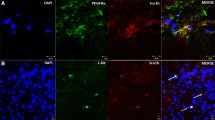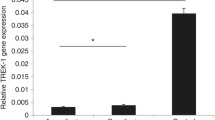Abstract
In Hirschsprung's disease (HD) there exists an overabundance of acetylcholine (ACh), which in turn stimulates excessive production of the enzyme acetylcholinesterase. Muscarinic ACh receptors (mAChRs) play an important role in smooth-muscle contraction. Recent studies have indicated five different subtypes of mAChRs encoded by five different genes, m1 to m5. The purpose of this study was to investigate the expression of each mAChR subtype in aganglionic (AG) colon to further understand the pathophysiology of HD. Entire colon resected at the time of pull-through operation for HD was obtained from 14 patients. Specimens obtained at autopsy from 8 age-matched patients without gastrointestinal disease acted as controls. Frozen sections were used for indirect immunohistochemistry as well as in-situ hybridization. Immunohistochemistry was performed using specific antiserum against each mAChR subtype and in-situ hybridization was performed using specific oligonucleotide probes against m1 to m5 subtypes. Messenger RNA (mRNA) was extracted from normoganglionic (NG) and AG bowel of HD patients and normal control bowel. Reverse transcription-polymerase chain reaction was performed to evaluate mRNA levels of each mAChR subtype. To adjust the levels of mRNA expression, a housekeeping gene G3PDH, known to be expressed normally, was used as an internal control. Strong m2 and m3 immunoreactivity was observed in the mucosal layer, smooth-muscle layers, and myenteric plexus of NG bowel, whereas m1 immunoreactivity was only detected in the mucosal layer. The most striking finding was the abundance of m3-immunoreactive fibers in muscle layers of NG bowel while there was a total lack of m3 fibers in smooth-muscle of AG bowel. Intense mRNA signals encoding m2 and m3 and to a lesser degree m1 were detected in NG bowel, and these signals were weak in AG bowel. Immunoreactivity and mRNA expression of m4 and m5 was not detected in NG or AG bowel. The lack of m3-immunoreactive fibers in the smooth-muscle layers of AG bowel and decreased m2 and m3 mRNA expression in AG bowel may be responsible for the motility dysfunction in the aganglionic segment.
Similar content being viewed by others
Author information
Authors and Affiliations
Rights and permissions
About this article
Cite this article
Oue, T., Yoneda, A., Shima, H. et al. Muscarinic acetylcholine receptor expression in aganglionic bowel. Pediatr Surg Int 16, 267–271 (2000). https://doi.org/10.1007/s003830050742
Issue Date:
DOI: https://doi.org/10.1007/s003830050742




